Diagonals of Compact Operators
John Jasper
South Dakota State University

The Pythagorean Theorem

Theorem. If \(\Delta\) is a right triangle with side lengths \(c\geq b\geq a\), then \[a^{2}+b^{2}=c^{2}.\]
\(a\)
\(b\)
\(c\)
The Pythagorean Theorem
Theorem. If \(v\) and \(w\) are orthogonal vectors, then \[\|v\|^2 + \|w\|^2 = \|v+w\|^2.\]
\(v\)
\(w\)
\(v+w\)
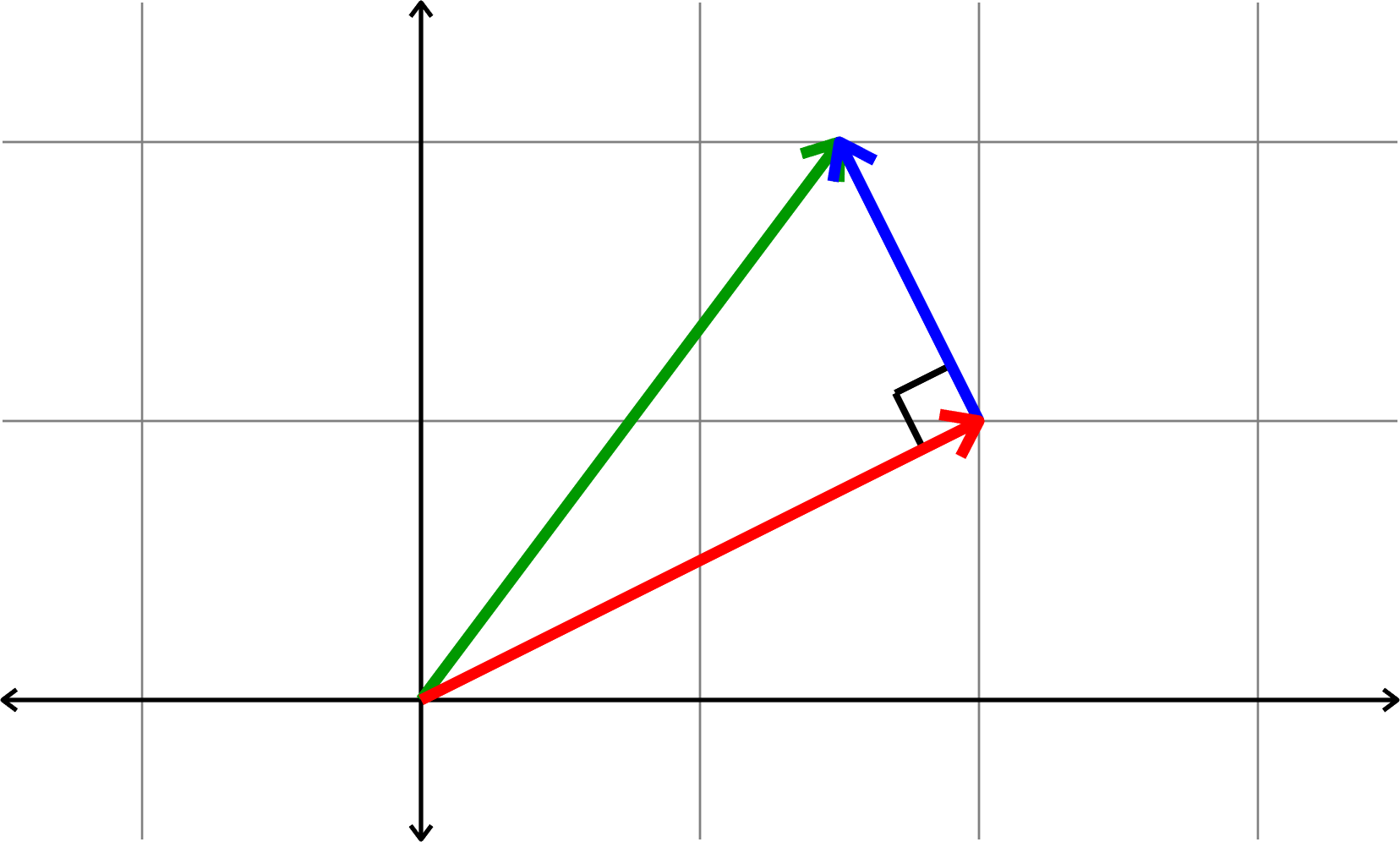
The Pythagorean Theorem
(The Standard Generalization)
Theorem. If \(v_{1},v_{2},\ldots,v_{k}\) are pairwise orthogonal vectors, then
\[\|v_{1}\|^2 + \|v_{2}\|^2 + \cdots + \|v_{k}\|^{2} = \|v_{1}+v_{2}+\cdots+v_{k}\|^2.\]
Kadison's Observation
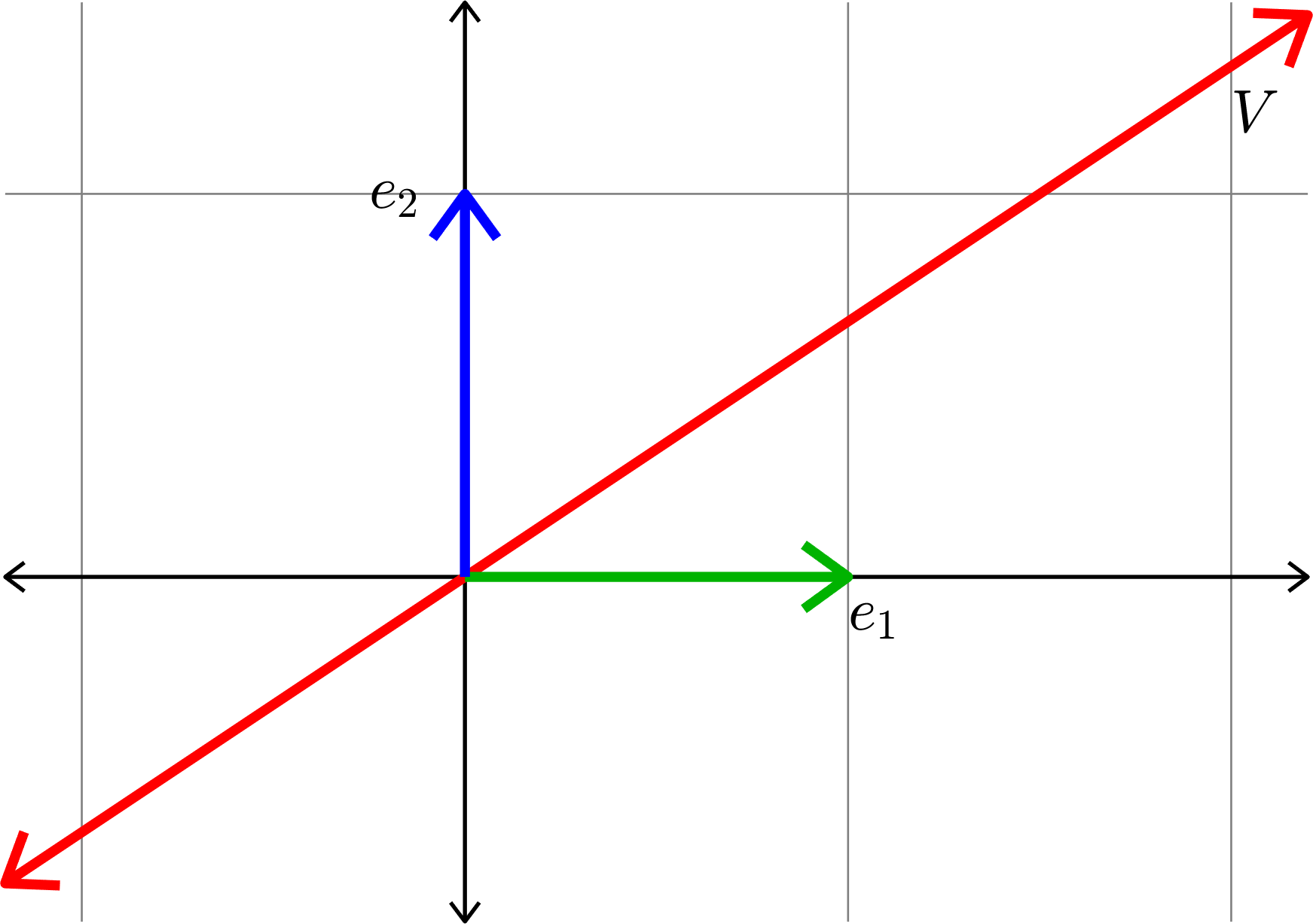
Kadison's Observation
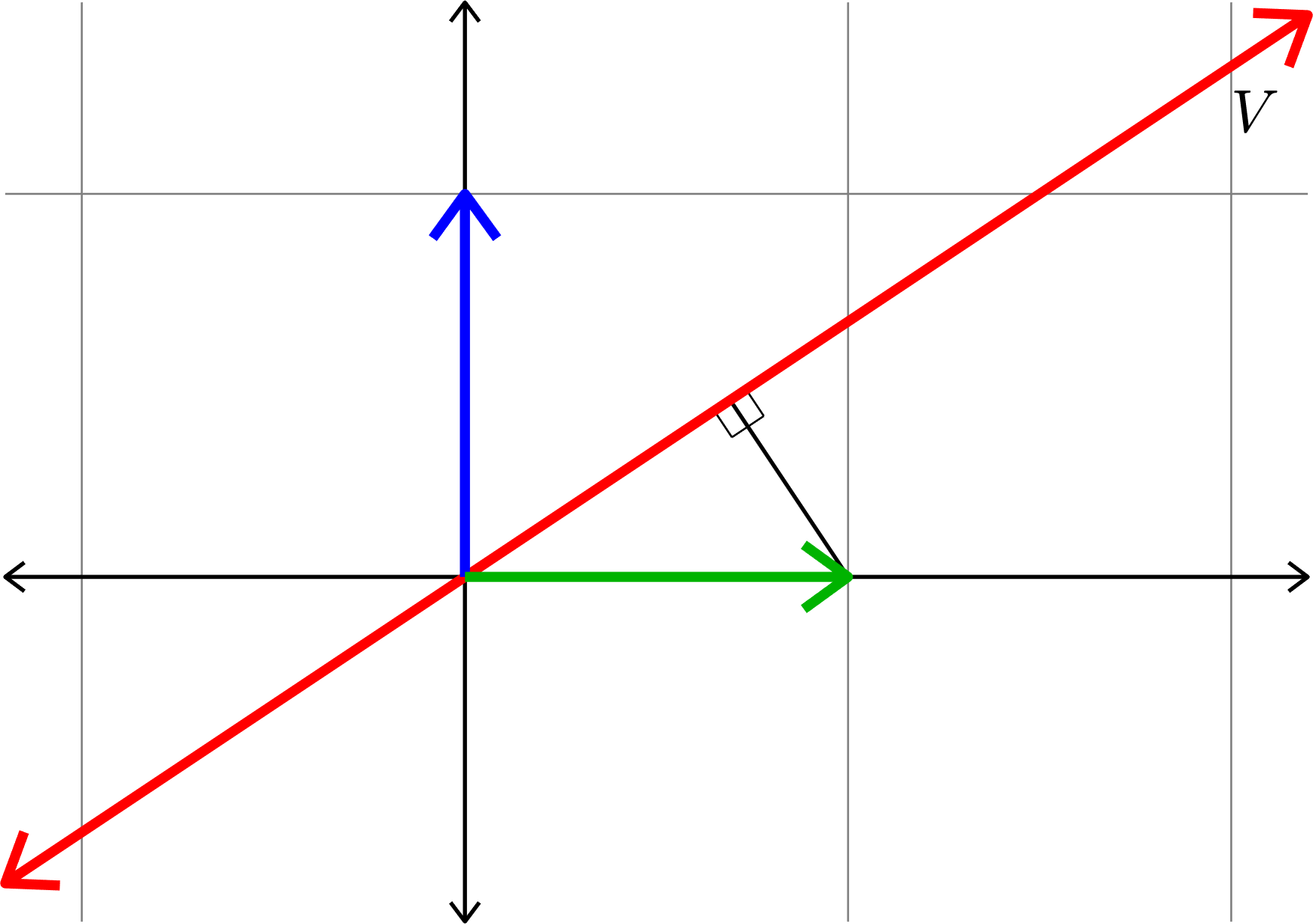
Kadison's Observation

Kadison's Observation
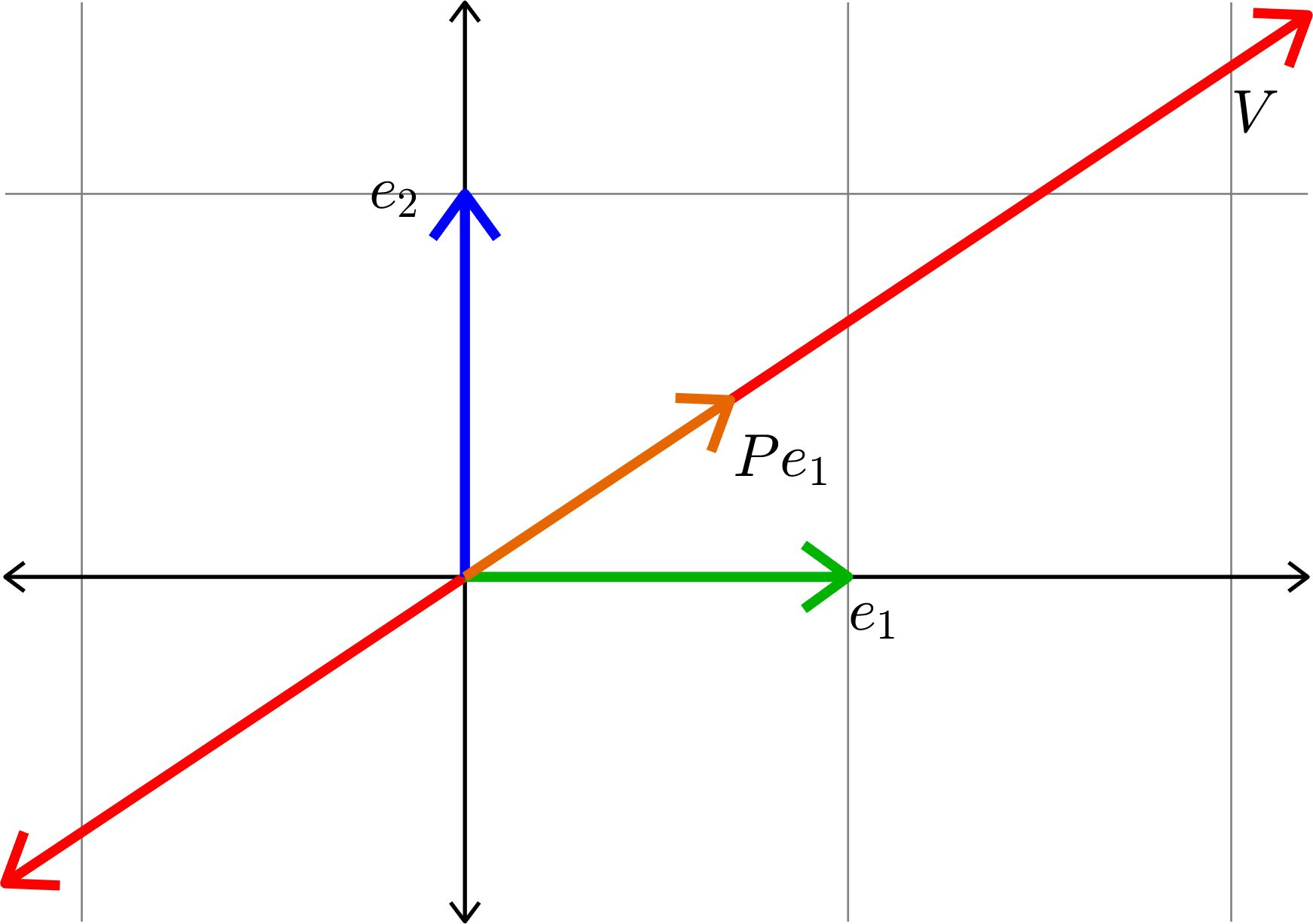
Kadison's Observation
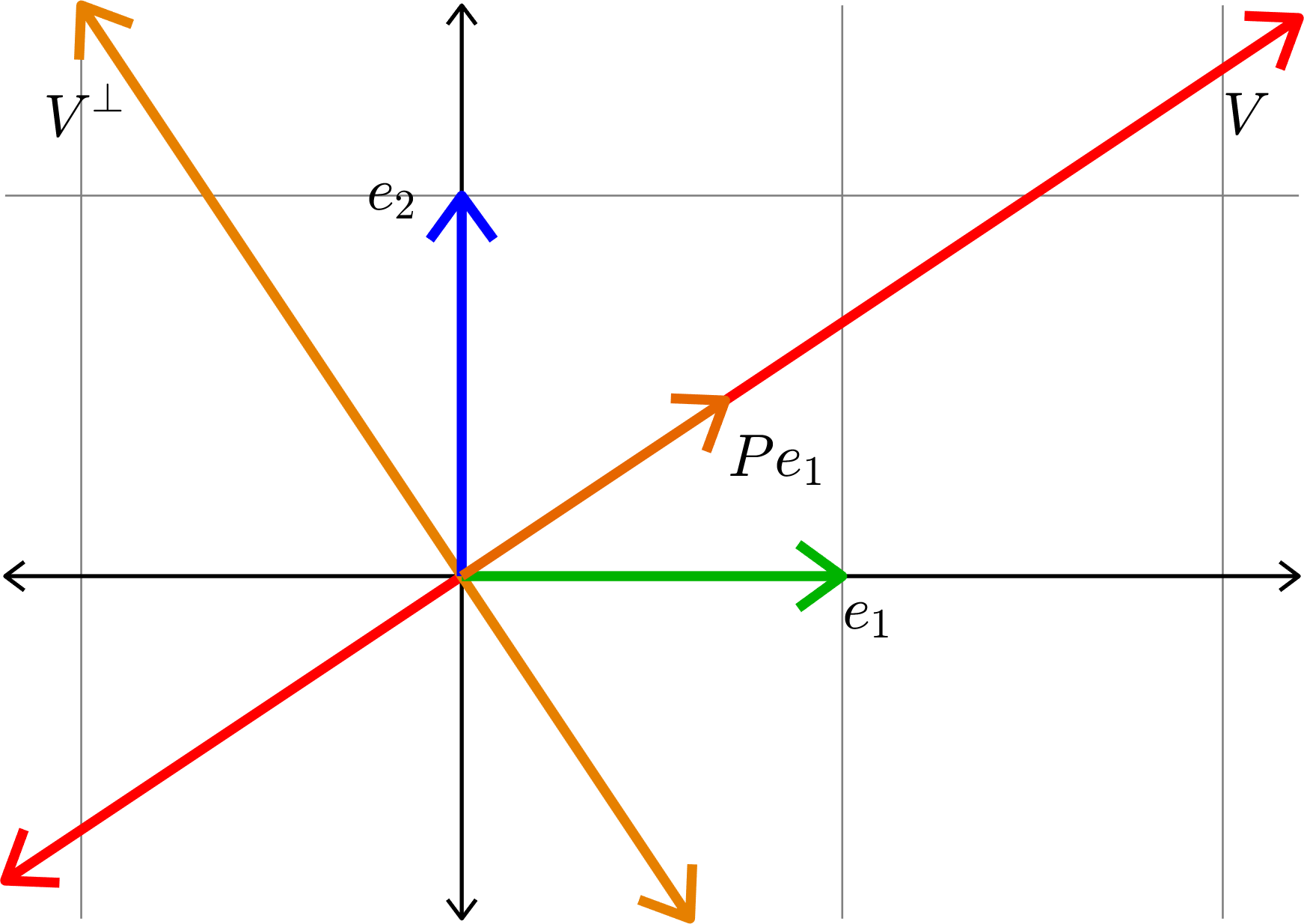
Kadison's Observation
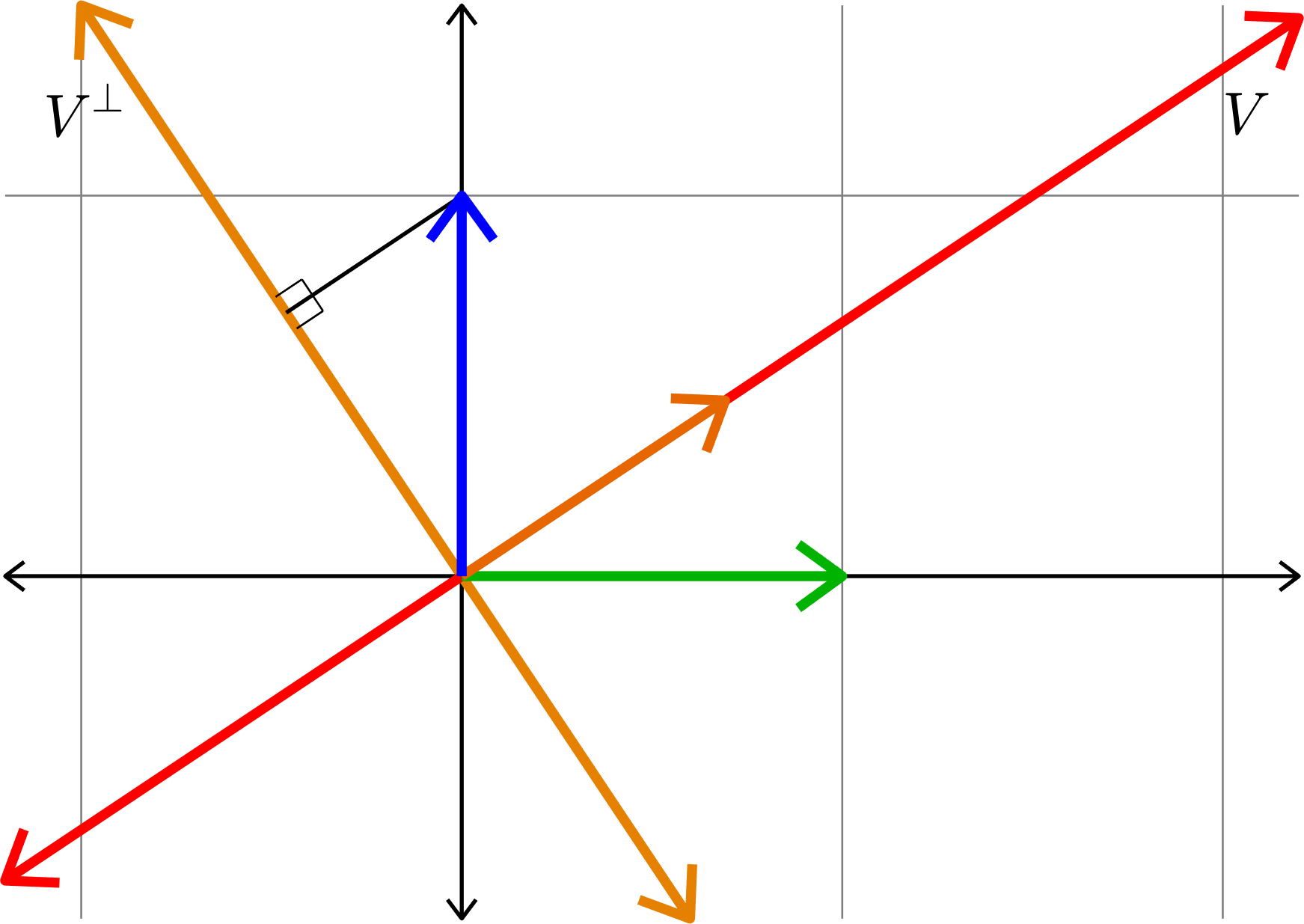
Kadison's Observation

Kadison's Observation
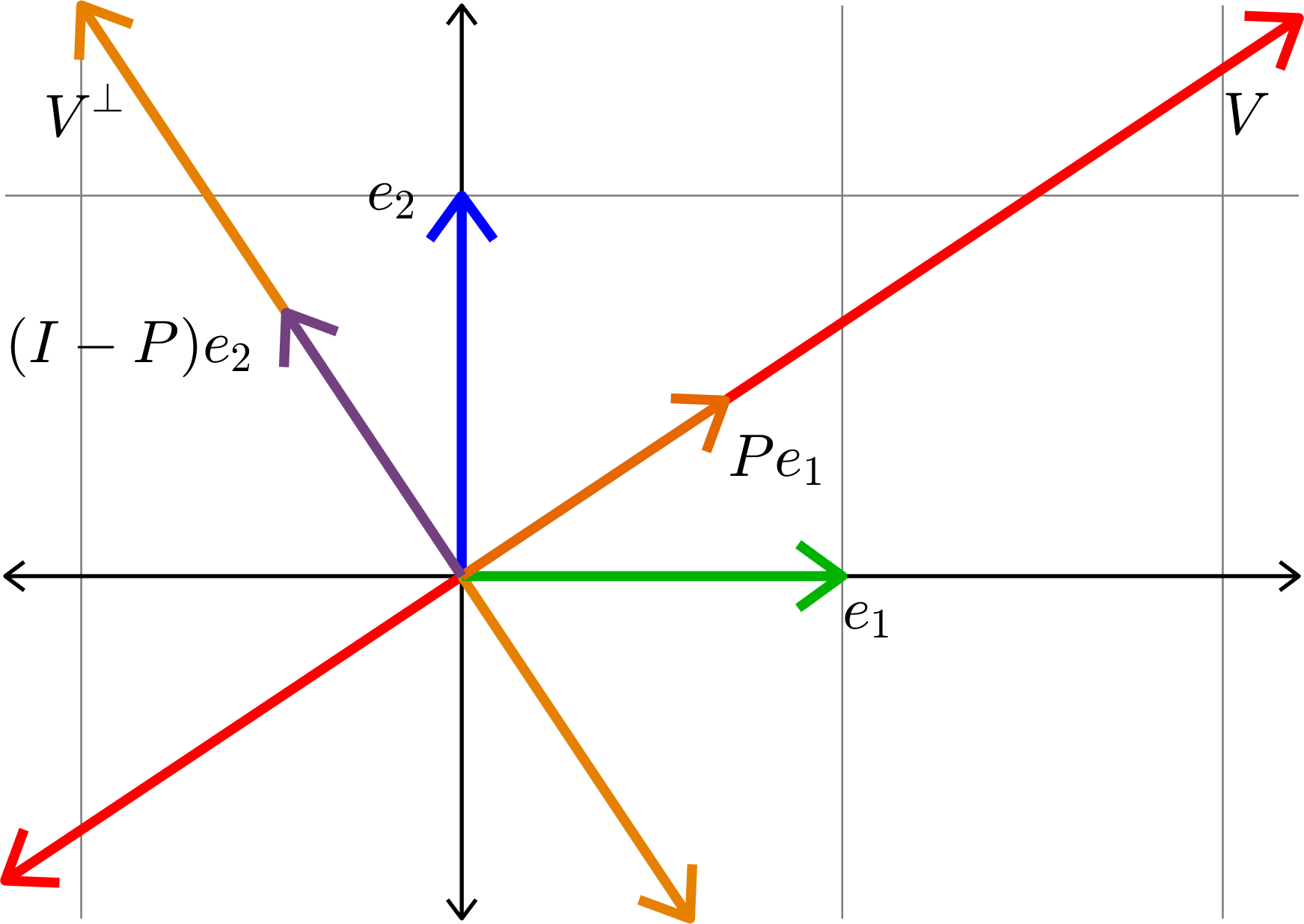
Kadison's Observation
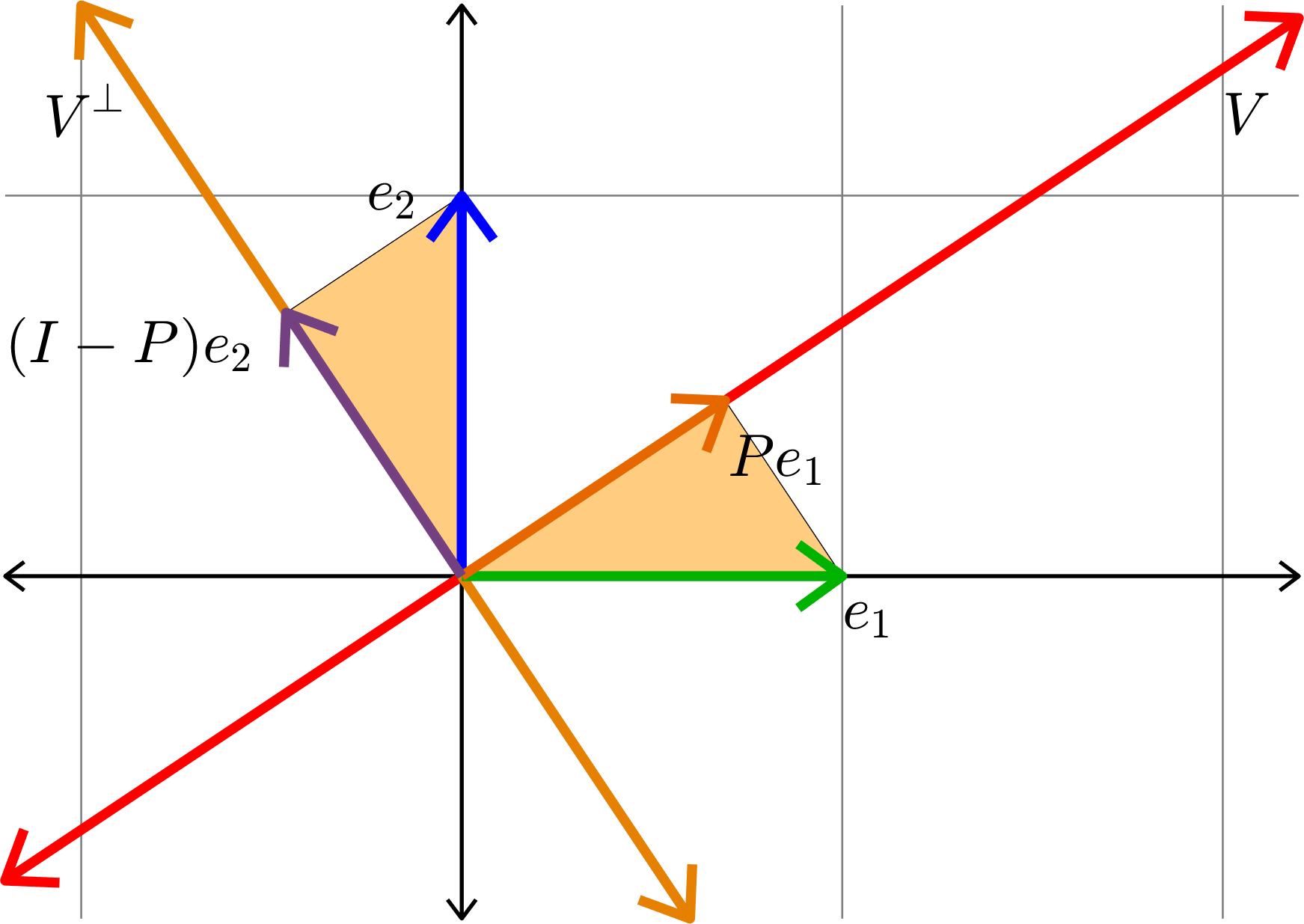
Similar Triangles!
\[\|(I-P)e_{2}\| = \|Pe_{1}\|\]
Kadison's Observation

Kadison's Observation
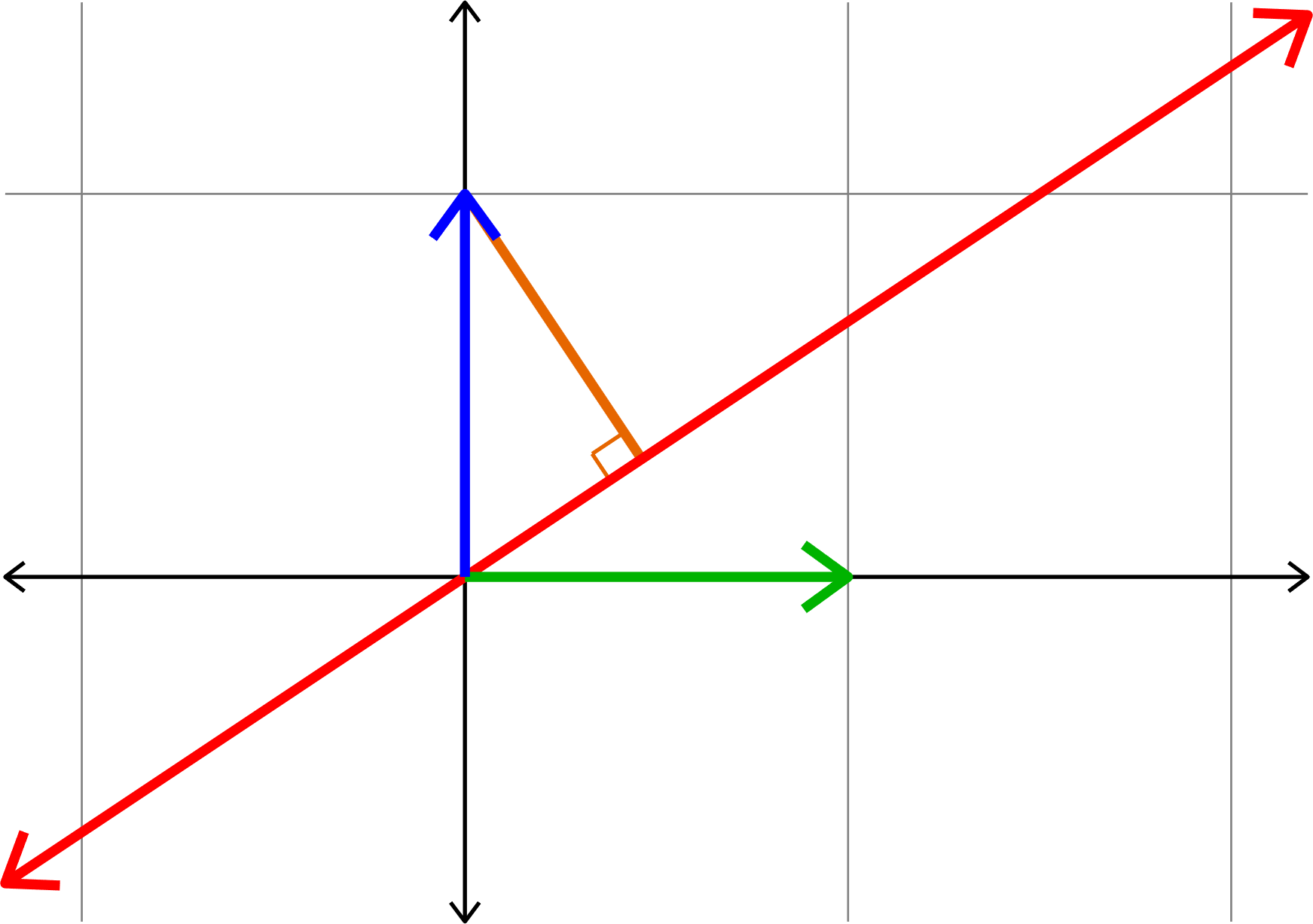
Kadison's Observation

Kadison's Observation
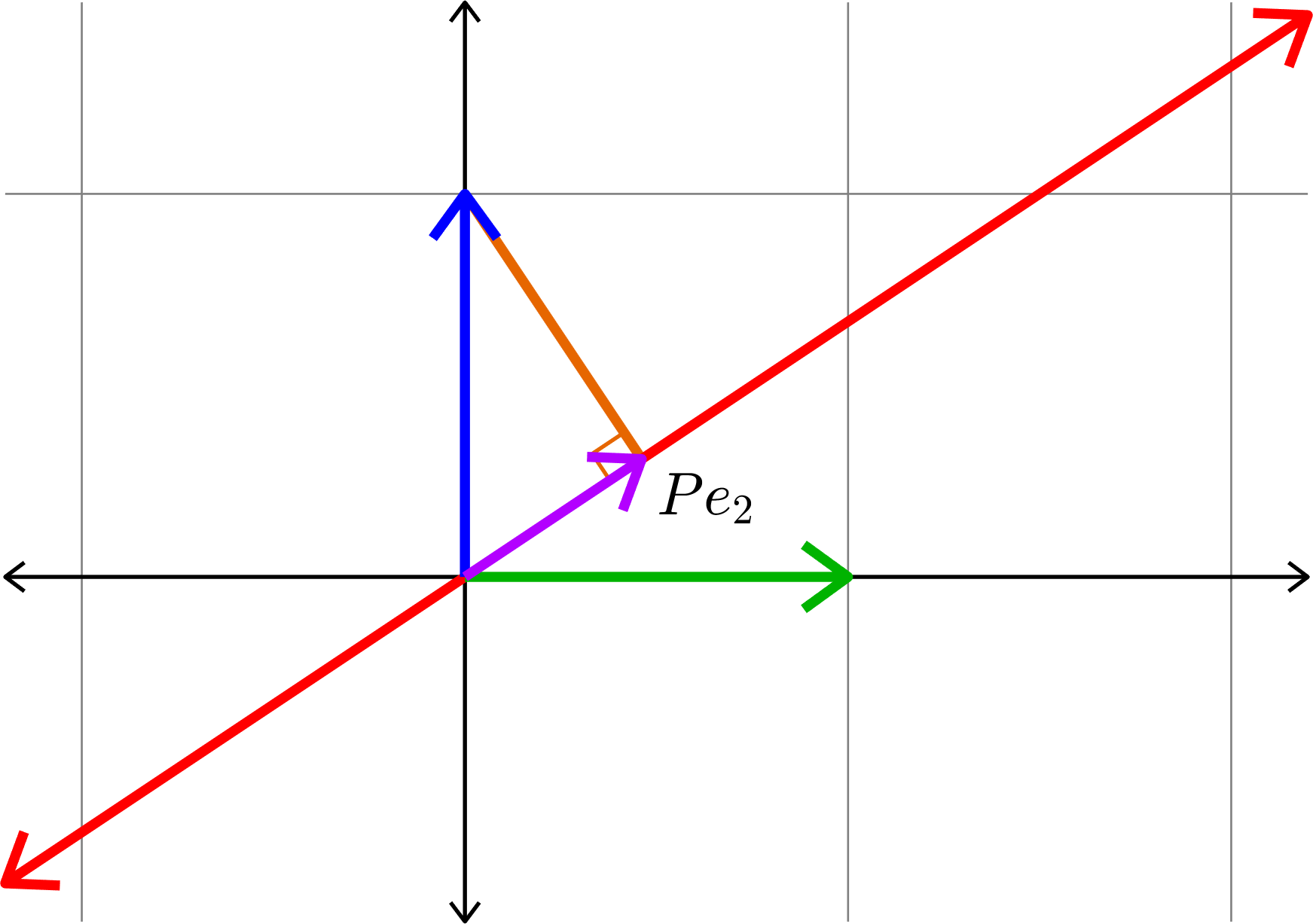
Kadison's Observation
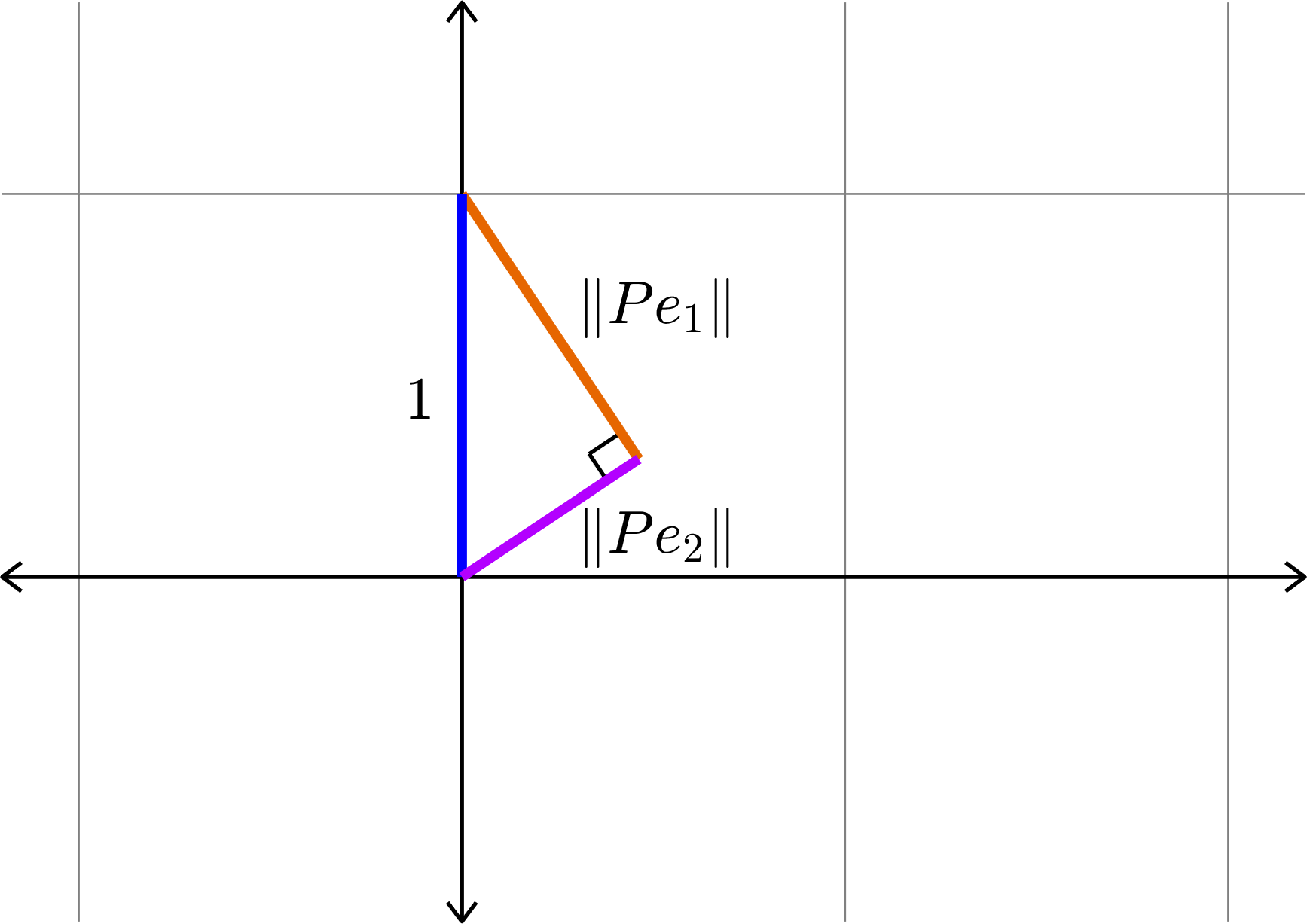
\[\|Pe_{1}\|^{2} + \|Pe_{2}\|^{2} = 1\]
The Pythagorean Theorem
Theorem. If \(P\) is an orthogonal projection onto a \(1\)-dimensional subspace \(V\), and \(\{e_{1},e_{2},\ldots,e_{n}\}\) is an orthonormal basis, then
\[\sum_{i=1}^{n}\|Pe_{i}\|^{2} = 1.\]
Proof.
- Let \(v\in V\) be a unit vector.
- \(Px = \langle x,v\rangle v,\)
- \(\|Pe_{i}\|^{2} = |\langle e_{i},v\rangle|^{2}\)
- \(\displaystyle{\sum_{i=1}^{n}\|Pe_{i}\|^{2} = \sum_{i=1}^{n}|\langle e_{i},v\rangle|^{2} = \|v\|^{2} = 1}.\)
\(\Box\)
The Pythagorean Theorem and Diagonals
If \(P\) is an orthogonal projection onto a subspace \(V\), and \((e_{i})_{i=1}^{n}\) is an orthonormal basis, then
\[\|Pe_{i}\|^{2} = \langle Pe_{i},Pe_{i}\rangle = \langle P^{\ast}Pe_{i},e_{i}\rangle = \langle P^{2}e_{i},e_{i}\rangle = \langle Pe_{i},e_{i}\rangle\]
\[ = \left[\begin{array}{cccc} \|Pe_{1}\|^{2} & \ast & \cdots & \ast\\ \overline{\ast} & \|Pe_{2}\|^{2} & & \vdots\\ \vdots & & \ddots & \vdots\\ \overline{\ast} & \cdots & \cdots & \|Pe_{n}\|^{2}\end{array}\right] \]
\[P= \left[\begin{array}{cccc} \langle Pe_{1},e_{1}\rangle & \langle Pe_{2},e_{1}\rangle & \cdots & \langle Pe_{n},e_{1}\rangle \\ \langle Pe_{1},e_{2}\rangle & \langle Pe_{2},e_{2}\rangle & & \vdots\\ \vdots & & \ddots & \vdots\\ \langle Pe_{1},e_{n}\rangle & \cdots & \cdots & \langle Pe_{n},e_{n}\rangle \end{array}\right]\]
The Pythagorean Theorem
Theorem. If \(P\) is an orthogonal projection onto a \(1\)-dimensional subspace \(V\), and \(\{e_{1},e_{2},\ldots,e_{n}\}\) is an orthonormal basis, then
\[\sum_{i=1}^{n}\|Pe_{i}\|^{2} = 1.\]
Proof. \[\sum_{i=1}^{n}\|Pe_{i}\|^{2} = \text{tr}(P) = \dim V = 1.\]
\(\Box\)
The Pythagorean Theorem
Theorem. If \(P\) is an orthogonal projection onto a \(k\)-dimensional subspace \(V\), and \(\{e_{1},e_{2},\ldots,e_{n}\}\) is an orthonormal basis, then
\[\sum_{i=1}^{n}\|Pe_{i}\|^{2} = k.\]
Proof. \[\sum_{i=1}^{n}\|Pe_{i}\|^{2} = \text{tr}(P) = \dim V = k.\]
\(\Box\)
Kadison's Pythagorean Theorem (finite dimensional)
Theorem. If \(P\) is an orthogonal projection onto a \(k\)-dimensional subspace \(V\), and \(\{e_{1},e_{2},\ldots,e_{n}\}\) is an orthonormal basis, then
\[\sum_{i=1}^{n}\|Pe_{i}\|^{2} = k.\]
Proof. \[\sum_{i=1}^{n}\|Pe_{i}\|^{2} = \text{tr}(P) = \dim V = k.\]
\(\Box\)
Corollary. If \(P\) is an orthogonal projection matrix onto a \(k\)-dimensional subspace, and \((d_{i})_{i=1}^{n}\) is the sequence on the diagonal of \(P\), then
\(d_{i}\in[0,1]\) for each \(i\), and
\[\sum_{i=1}^{n}d_{i} \in\Z\]
The Carpenter's Theorem
Theorem. If \(\Delta\) is a triangle with side lengths \(c\geq b\geq a\), such that
\(a^{2}+b^{2}=c^{2},\) then \(\Delta\) is a right triangle.
\(a\)
\(b\)
\(c\)
Proof. Law of cosines
\[c^2=a^2+b^2-2ab\cos(\theta).\]

\(\theta\)
Theorem. If \(v\) and \(w\) are vectors in a real Hilbert space such that
\(\|v\|^2 + \|w\|^2 = \|v+w\|^2,\) then \(\langle v,w\rangle = 0.\)
The Carpenter's Theorem
Proof.
\[\|v+w\|^2 = \langle v+w,v+w\rangle = \|v\|^2+2\langle v,w\rangle + \|w\|^{2}\]
\[\|v+w\|^2=\|v\|^2+\|w\|^2 \quad \Rightarrow\quad 2\langle v,w\rangle = 0. \quad \Box\]
Theorem. If \(d_{1},d_{2}\) are two numbers in \([0,1]\) such that \(d_{1}+d_{2} = 1,\) then there is a projection \(P\) such that \(d_{1} = \|Pe_{1}\|^2\) and \(d_{2} = \|Pe_{2}\|^2\), that is,
\[P = \begin{bmatrix} d_{1} & \alpha\\ \overline{\alpha} & d_{2}\end{bmatrix}.\]
Kadison's Carpenter's Theorem (2d)

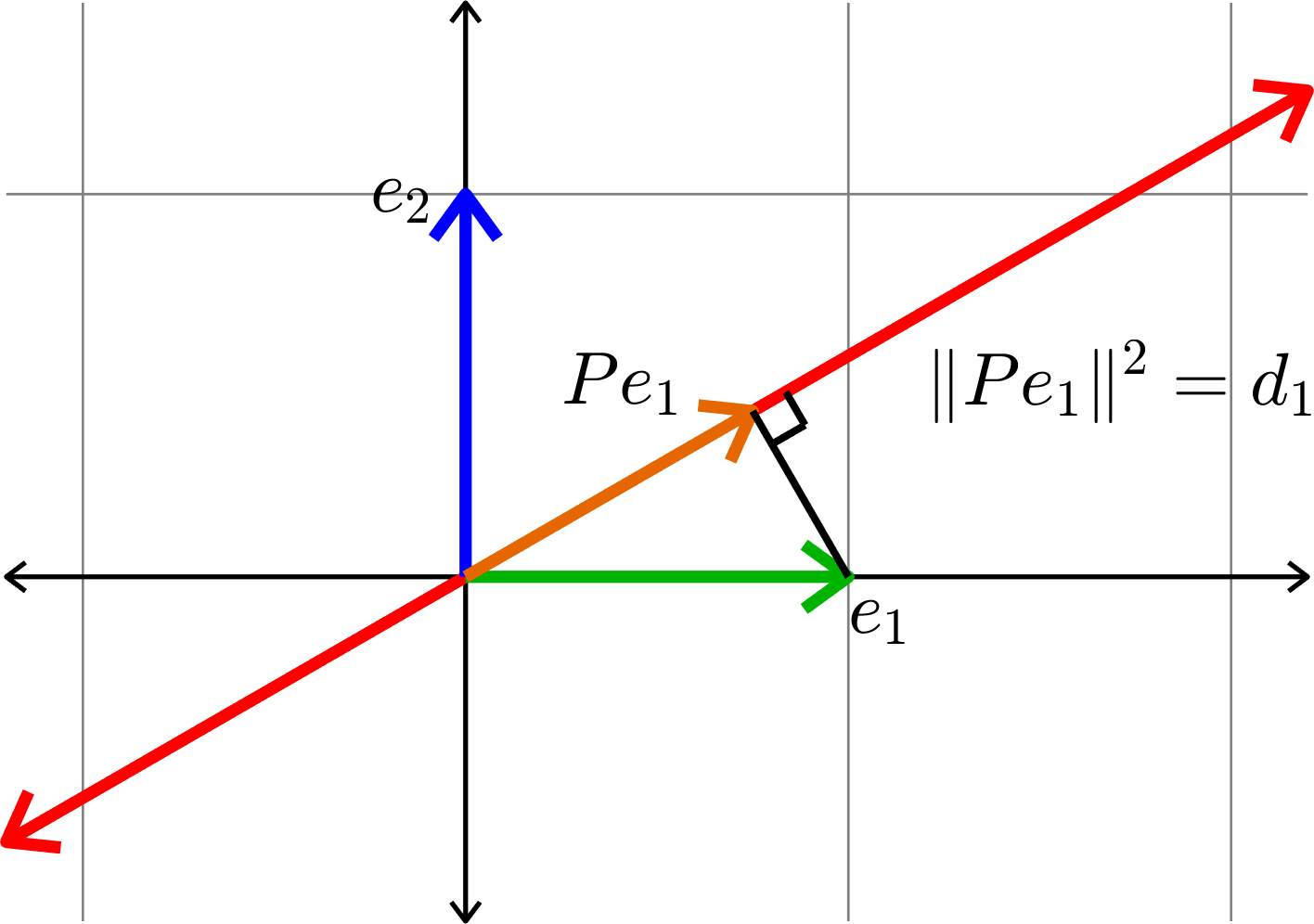
Proof.
- By the intermediate value theorem there is a projection \(P\) such that \(\|Pe_{1}\|^{2}=d_{1}.\)
- By the Pythagorean theorem \(\|Pe_{1}\|^2+\|Pe_{2}\|^2=1.\)
- Therefore, \[\|Pe_{2}\|^2=d_{2}.\]
Theorem. If \((d_{i})_{i=1}^{n}\) is a sequence of numbers in \([0,1]\) such that \[\sum_{i=1}^{n}d_{i}\in\N\cup\{0\},\] then there is an \(n\times n\) projection \(P\) such that \[\|Pe_{i}\|^{2} = d_{i} \quad\text{for}\quad i=1,\ldots,n.\]
Kadison's Carpenter's Theorem
\[\langle Pe_{i},e_{i}\rangle = \]
Note that this means that the sequence on the diagonal of the matrix \(P\) is \((d_{i})_{i=1}^{n}\).
Example. Consider the sequence
\[\left(\frac{5}{7},\frac{5}{7},\frac{3}{7},\frac{1}{7}\right).\]
\[\left[\begin{array}{rrrr}\frac{5}{7} & -\frac{\sqrt{15}}{21} & -\frac{\sqrt{30}}{21} & \frac{\sqrt{5}}{7}\\[1ex] -\frac{\sqrt{15}}{21} & \frac{5}{7} & -\frac{2\sqrt{2}}{7} & -\frac{\sqrt{3}}{21}\\[1ex] -\frac{\sqrt{30}}{21} & -\frac{2\sqrt{2}}{7} & \frac{3}{7} & -\frac{\sqrt{6}}{21}\\[1ex] \frac{\sqrt{5}}{7} & -\frac{\sqrt{3}}{21} & -\frac{\sqrt{6}}{21} & \frac{1}{7}\end{array}\right]\]
Challenge: Construct a \(4\times 4\) projection with this diagonal.
Theorem. Assume \((d_{i})_{i=1}^{n}\) is a sequence of numbers in \([0,1].\) There is an \(n\times n\) projection \(P\) with diagonal \((d_{i})_{i=1}^{n}\) if and only if
\[\sum_{i=1}^{n}d_{i} \in\N\cup\{0\}.\]
Characterization of Diagonals of Projections
in Finite Dimensions
Diagonality
Definition. Given an operator \(E\) on a Hilbert space, a sequence \((d_{i})_{i\in I}\) is a diagonal of \(E\) if there is an orthonormal basis \((e_{i})_{i\in I}\) such that
\[d_{i} = \langle Ee_{i},e_{i}\rangle \quad\text{for all }i\in I.\]
The problem: Given an operator \(E\), characterize the set of diagonals of \(E\), that is, the set
\[\big\{(\langle Ee_{i},e_{i}\rangle )_{i\in I} : (e_{i})_{i\in I}\text{ is an orthonormal basis}\big\}\]
In particular, we want a characterization in terms of linear inequalities between the diagonal sequences and the spectral information of \(E\).
Note: If we fix an orthonormal basis \((f_{i})_{i\in I}\), then the set of diagonals of \(E\) is also
\[\big\{(\langle UEU^{\ast}f_{i},f_{i}\rangle )_{i\in I} : U\text{ is unitary}\big\}\]
Projections in infinite dimensions
Examples. Let \((e_{i})_{i=1}^{\infty}\) be an orthonormal basis.
Set \(\displaystyle{v = \sum_{i=1}^{\infty}\sqrt{\frac{1}{2^{i}}}e_{i}},\) then
\[I-P = \begin{bmatrix} \frac{1}{2} & -\frac{1}{2^{3/2}} & -\frac{1}{2^{2}} & \cdots \\[1ex] -\frac{1}{2^{3/2}} & \frac{3}{4} & -\frac{1}{2^{5/2}} & \cdots\\[1ex] -\frac{1}{2^{2}} & -\frac{1}{2^{5/2}} & \frac{7}{8} & \cdots\\ \vdots & \vdots & \vdots & \ddots\end{bmatrix}\]
\[P = \langle \cdot,v\rangle v = \begin{bmatrix} \frac{1}{2} & \frac{1}{2^{3/2}} & \frac{1}{2^{2}} & \cdots \\[1ex] \frac{1}{2^{3/2}} & \frac{1}{4} & \frac{1}{2^{5/2}} & \cdots\\[1ex] \frac{1}{2^{2}} & \frac{1}{2^{5/2}} & \frac{1}{8} & \cdots\\[1ex] \vdots & \vdots & \vdots & \ddots\end{bmatrix}\]
Corank 1 projection
Diagonal: \(\displaystyle{\left(\frac{1}{2},\frac{3}{4},\frac{7}{8},\ldots\right)}\)
Rank 1 projection
Diagonal: \(\displaystyle{\left(\frac{1}{2},\frac{1}{4},\frac{1}{8},\ldots\right)}\)
Projections in infinite dimensions
Examples.
\[\frac{1}{2}J_{2} = \begin{bmatrix} \frac{1}{2} & \frac{1}{2}\\[1ex] \frac{1}{2} & \frac{1}{2}\end{bmatrix}\]
\[Q = \bigoplus_{i=1}^{\infty}\frac{1}{2}J_{2} = \begin{bmatrix} \frac{1}{2}J_{2} & \mathbf{0} & \mathbf{0} & \cdots\\ \mathbf{0} & \frac{1}{2}J_{2} & \mathbf{0} & \cdots\\ \mathbf{0} & \mathbf{0} & \frac{1}{2}J_{2} & \\ \vdots & \vdots & & \ddots\end{bmatrix}\]
\(\infty\)-rank and \(\infty\)-corank
Diagonal: \(\displaystyle{\left(\frac{1}{2},\frac{1}{2},\frac{1}{2},\ldots\right)}\)
\(\infty\)-rank and \(\infty\)-corank
Diagonal: \(\displaystyle{\left(\ldots,\frac{1}{8},\frac{1}{4},\frac{1}{2},\frac{1}{2},\frac{3}{4},\frac{7}{8},\ldots\right)}\)
\[P\oplus (I-P)\]
Theorem. Assume \((d_{i})_{i=1}^{n}\) is a sequence of numbers in \([0,1].\) There is an \(n\times n\) projection \(P\) with diagonal \((d_{i})_{i=1}^{n}\) if and only if
\[\sum_{i=1}^{n}d_{i} \in\N\cup\{0\}.\]
Diagonals of Projections Redux
\[\sum_{i=1}^{k}d_{i} - \sum_{i=k+1}^{n}(1-d_{i})\in\Z\]
\[\Updownarrow\]
Theorem. Assume \((d_{i})_{i=1}^{n}\) is a sequence of numbers in \([0,1].\) There is an \(n\times n\) projection \(P\) with diagonal \((d_{i})_{i=1}^{n}\) if and only if
\[\sum_{i=1}^{k}d_{i} - \sum_{i=k+1}^{n}(1-d_{i})\in\Z.\]
Diagonals of Projections Redux
Theorem (Kadison '02). Assume \((d_{i})_{i=1}^{\infty}\) is a sequence of numbers in \([0,1],\) and set
\[a=\sum_{d_{i}<\frac{1}{2}}d_{i}\quad\text{and}\quad b=\sum_{d_{i}\geq \frac{1}{2}}(1-d_{i})\]
There is a projection \(P\) with diagonal \((d_{i})_{i=1}^{\infty}\) if and only if one of the following holds:
- \(a=\infty\)
- \(b=\infty\)
- \(a,b<\infty\) and \(a-b\in\Z\)
Kadison's Theorem
Examples.
- There is a projection with every number in \(\mathbb{Q}\cap[0,1]\) on the diagonal.
- There is a projection with diagonal \((\frac{\pi}{4},\frac{\pi}{4},\frac{\pi}{4},\ldots)\).
- There is no projection with diagonal \[\left(\ldots,\frac{1}{25},\frac{1}{16},\frac{1}{9},\frac{1}{4},\frac{1}{2},\frac{3}{4},\frac{7}{8},\frac{15}{16},\ldots\right)\]
Diagonals of \(2\times 2\) self-adjoint matrices
Up to unitary equivalence \(E=\begin{bmatrix} \lambda_{1} & 0\\ 0 & \lambda_{2}\end{bmatrix}\), with \(\lambda_{1}\geq \lambda_{2}\).
\[\begin{bmatrix}\cos\theta & -\sin\theta\\ \sin\theta & \cos\theta\end{bmatrix}\begin{bmatrix} \lambda_{1} & 0\\ 0 & \lambda_{2}\end{bmatrix}\begin{bmatrix}\cos\theta & \sin\theta\\ -\sin\theta & \cos\theta\end{bmatrix}\]
\[= \begin{bmatrix}\alpha\lambda_{1}+(1-\alpha)\lambda_{2} & \ast\\ \overline{\ast} & (1-\alpha)\lambda_{1} + \alpha\lambda_{2} \end{bmatrix},\quad (\alpha = \cos^{2}\theta)\]
Hence \((d_{1},d_{2})\), with \(d_{1}\geq d_{2}\), is a diagonal of \(E\) if and only if
and
\[\lambda_{1}+\lambda_{2}=d_{1}+d_{2}\].
\(\lambda_{2}\leq d_{1}\leq\lambda_{1}\)
\[d_{1}\in\operatorname{conv}(\{\lambda_{1},\lambda_{2}\})\]
\( d_{1}\leq\lambda_{1}\)
Givens rotations
\[\begin{bmatrix}\cos\theta & -\sin\theta & 0\\ \sin\theta & \cos\theta & 0\\ 0 & 0 & 1\end{bmatrix}\begin{bmatrix} \lambda_{1} & 0 & 0\\ 0 & \lambda_{2} & 0\\ 0 & 0 & \lambda_{3}\end{bmatrix}\begin{bmatrix}\cos\theta & \sin\theta & 0\\ -\sin\theta & \cos\theta & 0\\ 0 & 0 & 1\end{bmatrix}\]
\[= \begin{bmatrix}\alpha\lambda_{1}+(1-\alpha)\lambda_{2} & \ast & 0\\ \overline{\ast} & (1-\alpha)\lambda_{1} + \alpha\lambda_{2} & 0\\ 0 & 0 & \lambda_{3}\end{bmatrix},\quad (\alpha = \cos^{2}\theta)\]
Suppose \(E = \left[\begin{smallmatrix} \lambda_{1} & 0 & 0\\ 0 & \lambda_{2} & 0\\ 0 & 0 & \lambda_{3}\end{smallmatrix}\right]\) with \(\lambda_{1}\geq \lambda_{2}\geq\lambda_{3}\)
\[\begin{bmatrix}\cos\theta & 0 & -\sin\theta\\ 0 & 1 & 0\\ \sin\theta & 0 & \cos\theta\end{bmatrix}\begin{bmatrix} \mu_{1} & \ast & 0\\ \overline{\ast} & \mu_{2} & 0\\ 0 & 0 & \mu_{3}\end{bmatrix}\begin{bmatrix}\cos\theta & 0 & \sin\theta\\ 0 & 1 & 0\\ -\sin\theta & 0 & \cos\theta\end{bmatrix}\]
\[= \begin{bmatrix}\alpha\mu_{1}+(1-\alpha)\lambda_{3} & \ast & \ast\\ \overline{\ast} & \mu_{2} & \ast\\ \overline{\ast} & \overline{\ast} & (1-\alpha)\mu_{1} + \alpha\mu_{3}\end{bmatrix},\quad (\alpha = \cos^{2}\theta)\]
Diagonals of \(3\times 3\) & \(4\times 4\) self-adjoint matrices
Suppose \(E = \left[\begin{smallmatrix} \lambda_{1} & 0 & 0\\ 0 & \lambda_{2} & 0\\ 0 & 0 & \lambda_{3}\end{smallmatrix}\right]\) with \(\lambda_{1}\geq \lambda_{2}\geq\lambda_{3}\)
Then \((d_{1},d_{2},d_{3})\), with \(d_{1}\geq d_{2}\geq d_{3}\) is a diagonal of \(E\) if and only if
\[d_{i}\in\operatorname{conv}\{\lambda_{1},\lambda_{2},\lambda_{3}\}\quad\forall\,i\]
and
\[d_{1}+d_{2}+d_{3}=\lambda_{1}+\lambda_{2}+\lambda_{3}.\]
However, \((7,6,1,1)\) is not a diagonal of \(E = \left[\begin{matrix} 8 & 0 & 0 & 0\\ 0 & 4 & 0 & 0\\ 0 & 0 & 2 & 0\\ 0 & 0 & 0 & 1\end{matrix}\right]\)
\(d_{1}\leq \lambda_{1}\), \(d_{1}+d_{2}\leq \lambda_{1}+\lambda_{2}\),
Even though \[7,6,1\in\operatorname{conv}(\{8,4,2,1\})=[1,8]\]
and \[7+6+1+1=15=8+4+2+1\]
\(7+6=13\not\leq 12=8+4\)
The Schur-Horn Theorem
Theorem (Schur '23, Horn '54). Let \((d_{i})_{i=1}^{n}\) and \((\lambda_{i})_{i=1}^{n}\) be nonincreasing sequences. There is a self-adjoint matrix \(E\) with diagonal \((d_{i})_{i=1}^{n}\) and eigenvalues \((\lambda_{i})_{i=1}^{n}\) if and only if
\[\sum_{i=1}^{k}d_{i}\leq \sum_{i=1}^{k}\lambda_{i}\quad\text{for}\quad k=1,2,\ldots,n-1\]
and
\[\sum_{i=1}^{n}d_{i} = \sum_{i=1}^{n}\lambda_{i}.\]
(1)
(2)
If (1) and (2) hold, then we say that \((\lambda_{i})_{i=1}^{n}\) majorizes \((d_{i})_{i=1}^{n}\), and we write \((\lambda_{i})_{i=1}^{n}\succeq (d_{i})_{i=1}^{n}\)
\((\lambda_{i})_{i=1}^{n}\succeq (d_{i})_{i=1}^{n}\) is equivalent to saying that \((d_{i})_{i=1}^{n}\) is in the convex hull of the permutations of \((\lambda_{i})_{i=1}^{n}\).
Theorem (Arveson, Kadison '06, Kaftal, Weiss '10). Let \((\lambda_{i})_{i=1}^{\infty}\) be a positive nonincreasing sequence, and let \((d_{i})_{i=1}^{\infty}\) be a nonnegative nonincreasing sequence. There exists a positive compact operator with positive eigenvalues \((\lambda_{i})_{i=1}^{\infty}\) and diagonal \((d_{i})_{i=1}^{\infty}\) if and only if
\[\sum_{i=1}^{k}d_{i}\leq \sum_{i=1}^{k}\lambda_{i}\quad\text{for all}\quad k\in\N\]
and
\[\sum_{i=1}^{\infty}d_{i} = \sum_{i=1}^{\infty}\lambda_{i}.\]
Open question: What are the diagonals of positive compact operators with positive eigenvalues
\[\left(1,\frac{1}{2},\frac{1}{3},\ldots\right)\] and a \(1\)-dimensional kernel.
Non-positive operators
Example. Consider the diagonal matrix \(E = \operatorname{diag}(-1,1,\frac{1}{2},\frac{1}{4},\frac{1}{8},\ldots)\)
\[\begin{bmatrix} -1 & 0 & 0 & 0 & \cdots\\ 0 & 1 & 0 & 0 & \cdots\\ 0 & 0 & \frac{1}{2} & 0 & \cdots\\ 0 & 0 & 0 & \frac{1}{4}\\ \vdots & \vdots & \vdots & & \ddots\end{bmatrix} \simeq \begin{bmatrix} -\frac{1}{2} & \ast & 0 & 0 & \cdots\\ \overline{\ast} & \frac{1}{2} & 0 & 0 & \cdots\\ 0 & 0 & \frac{1}{2} & 0 & \cdots\\ 0 & 0 & 0 & \frac{1}{4}\\ \vdots & \vdots & \vdots & & \ddots\end{bmatrix} \simeq \begin{bmatrix} -\frac{1}{4} & \ast & \ast & 0 & \cdots\\ \overline{\ast} & \frac{1}{2} & \ast & 0 & \cdots\\ \overline{\ast} & \overline{\ast} & \frac{1}{4} & 0 & \cdots\\ 0 & 0 & 0 & \frac{1}{4}\\ \vdots & \vdots & \vdots & & \ddots\end{bmatrix}\]
\[\simeq\cdots\simeq \begin{bmatrix} 0 & \ast & \ast & \ast & \cdots\\ \overline{\ast} & \frac{1}{2} & \ast & \ast & \cdots\\ \overline{\ast} & \overline{\ast} & \frac{1}{4} & \ast & \cdots\\ \overline{\ast} & \overline{\ast} & \overline{\ast} & \frac{1}{8}\\ \vdots & \vdots & \vdots & & \ddots\end{bmatrix}\]
Hence, \((0,\frac{1}{2},\frac{1}{4},\frac{1}{8},\ldots)\) is a diagonal of \(E\).





Definition. Let \(\boldsymbol\lambda =\{\lambda_i\}_{i\in I}\in c_0\). Define its positive part \(\boldsymbol\lambda_+ =\{\lambda^{+}_i\}_{i\in I}\) by \(\lambda^+_i=\max(\lambda_i,0)\). The negative part is defined as \(\boldsymbol\lambda_-=(-\boldsymbol \lambda)_+.\)
If \(\boldsymbol\lambda \in c_0^+\), then define its decreasing rearrangement \(\boldsymbol\lambda^{\downarrow} =\{\lambda^{\downarrow}_i\}_{i\in \N}\) by taking \(\lambda^{\downarrow}_i\) to be the \(i\)th largest term of \(\boldsymbol \lambda.\) For the sake of brevity, we will denote the \(i\)th term of \((\boldsymbol\lambda_{+})^{\downarrow}\) by \(\lambda_{i}^{+\downarrow}\), and similarly for \((\boldsymbol\lambda_{-})^{\downarrow}\).
\[-\lambda^{-\downarrow}_{1}\leq -\lambda^{-\downarrow}_{2}\leq-\lambda^{-\downarrow}_{3}\leq\cdots\leq 0\leq\cdots\leq \lambda^{+\downarrow}_{3}\leq \lambda^{+\downarrow}_{2}\leq \lambda^{+\downarrow}_{1}\]
Hence, we have "rearranged" the sequence \(\boldsymbol\lambda\) as follows:
Note:
If \(\boldsymbol\lambda\) has infinitely many positive terms, then \(\boldsymbol\lambda_{+}\) has no zeros.
If \(\boldsymbol\lambda\) has finitely many positive terms, then \(\boldsymbol\lambda_{+}\) has infinitely many zeros.
Rearranging sequences
Excess
Given a compact self-adjoint operator \(E\) with eigenvalue list \(\boldsymbol\lambda\), it is straightforward to show that if \(\boldsymbol{d}\in c_{0}\) is a diagonal of \(E\), then
\[\sum_{i=1}^n \lambda_i^{+ \downarrow} \geq \sum_{i=1}^n d_i^{+ \downarrow} \quad\text{and }\quad \sum_{i=1}^n \lambda_i^{- \downarrow} \ge \sum_{i=1}^n d_i^{- \downarrow} \qquad\text{for all }k\in \N,\]
But it is not true that
\[\sum_{i=1}^\infty d_{i}^{+} = \sum_{i=1}^{\infty}\lambda_{i}^{+}\quad\text{and}\quad \sum_{i=1}^\infty d_{i}^{-} = \sum_{i=1}^{\infty}\lambda_{i}^{-}\]
Indeed, \((0,\frac{1}{2},\frac{1}{4},\frac{1}{8},\ldots)\) is a diagonal of an operator with eigenvalue list \((-1,1,\frac{1}{2},\frac{1}{4},\frac{1}{8},\ldots)\).
We need to keep track of how much "mass" was moved across zero:
\[\sigma_{+} = \liminf_{n\to\infty} \sum_{i=1}^n (\lambda_i^{+ \downarrow} - d_i^{+ \downarrow})\quad\text{and}\quad \sigma_{-} = \liminf_{n\to\infty} \sum_{i=1}^n (\lambda_i^{- \downarrow} - d_i^{- \downarrow})\]
\[\sigma_{+} = \sum_{i=1}^n (\lambda_i^{+ \downarrow} - d_i^{+ \downarrow})\quad\text{and}\quad \sigma_{-} = \sum_{i=1}^n (\lambda_i^{- \downarrow} - d_i^{- \downarrow})\]
Theorem (Bownik, J '22) Let \(\boldsymbol\lambda,\boldsymbol{d}\in c_{0}\). Set
\[\sigma_{+} = \liminf_{n\to\infty} \sum_{i=1}^n (\lambda_i^{+ \downarrow} - d_i^{+ \downarrow})\quad\text{and}\quad \sigma_{-} = \liminf_{n\to\infty} \sum_{i=1}^n (\lambda_i^{- \downarrow} - d_i^{- \downarrow})\]
Let \(A\) be a compact self-adjoint operator with eigenvalue list \(\boldsymbol\lambda.\)
The sequence \(\boldsymbol d\) is a diagonal of an operator \(B\) such that \(A\oplus \boldsymbol 0\) and
\(B \oplus \boldsymbol 0\) are unitarily equivalent, where \(\boldsymbol 0\) denotes the zero operator on an infinite dimensional Hilbert space, if and only if the following four conditions hold:
\[\sum_{i=1}^n \lambda_i^{+ \downarrow} \geq \sum_{i=1}^n d_i^{+ \downarrow} \quad\text{and }\quad \sum_{i=1}^n \lambda_i^{- \downarrow} \ge \sum_{i=1}^n d_i^{- \downarrow} \qquad\text{for all }k\in \N,\]
\[\boldsymbol d_+ \in \ell^1 \quad \implies\quad \sigma_{-}\geq \sigma_{+}.\]
\[\boldsymbol d_- \in \ell^1 \quad \implies\quad \sigma_{+}\geq \sigma_{-}\]
Note: If \(\boldsymbol d\in\ell^{1}\) (\(A\) is trace class), then \(\sigma_{-} = \sigma_{+}\). That is \(\sum d_{i} = \sum\lambda_{i}\).
Theorem (Bownik, J '22) Let \(\boldsymbol\lambda,\boldsymbol{d}\in c_{0}\). Let \(A\) be a compact self-adjoint operator with eigenvalue list \(\boldsymbol\lambda.\) If
\[\sum_{i=1}^n \lambda_i^{+ \downarrow} \geq \sum_{i=1}^n d_i^{+ \downarrow} \quad\text{and }\quad \sum_{i=1}^n \lambda_i^{- \downarrow} \ge \sum_{i=1}^n d_i^{- \downarrow} \qquad\text{for all }k\in \N,\]
and
\[\sigma_{+}=\sigma_{-}\in(0,\infty).\]
then, the sequence \(\boldsymbol d\) is a diagonal of \(A\).
In some special cases we can get a stronger sufficiency result:
Not some operator with a different sized kernel.
Where did it go?
Example. Set \[\boldsymbol\lambda = \left(-1,1,\frac{1}{2},\frac{1}{4},\frac{1}{8},\ldots\right)\] and \[\boldsymbol{d} =\left (\frac{1}{2},\frac{1}{4},\frac{1}{8},\ldots\right)\]
Then \[\sigma_{+}=\sigma_{-}=1\in(0,\infty),\] and clearly
\[\sum_{i=1}^n \lambda_i^{+ \downarrow} \geq \sum_{i=1}^n d_i^{+ \downarrow} \quad\text{and }\quad \sum_{i=1}^n \lambda_i^{- \downarrow} \ge \sum_{i=1}^n d_i^{- \downarrow} \qquad\text{for all }k\in \N,\]
So, \((0,\frac{1}{2},\frac{1}{4},\frac{1}{8},\cdots)\) and \((\frac{1}{2},\frac{1}{4},\frac{1}{8},\cdots)\) are diagonals of \(E=\operatorname{diag}(\boldsymbol\lambda)\).
Thanks!

- This work was partially supported by NSF #1830066
- Webpage: https://sites.google.com/view/john-jasper-math/home
- Slides: https://slides.com/johnjasper
Oregon Analysis
By John Jasper
Oregon Analysis
- 519



